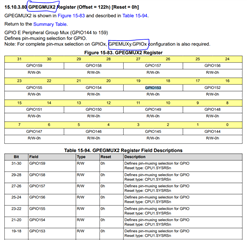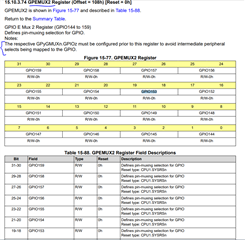Other Parts Discussed in Thread: SYSCONFIG
Hi All
A 2.5 MHz clock is generated on the PWM pin.
Before the design change, GPIO6/7 (ePWM4A/4B) could generate the clock without problems,
but when the pins were changed to GPIO167/168 (ePWM12A/12B), the output was not generated.
The pin settings are the same before and after the change.
1, Can all ePWM pins be used in the same way? Or are there functional restrictions depending on the pin?
2, If there are functional restrictions, is there any way to generate a 2.5MHz clock signal from GPIO167/168 (ePWM12A/12B)?
Best Regards,
Ito





